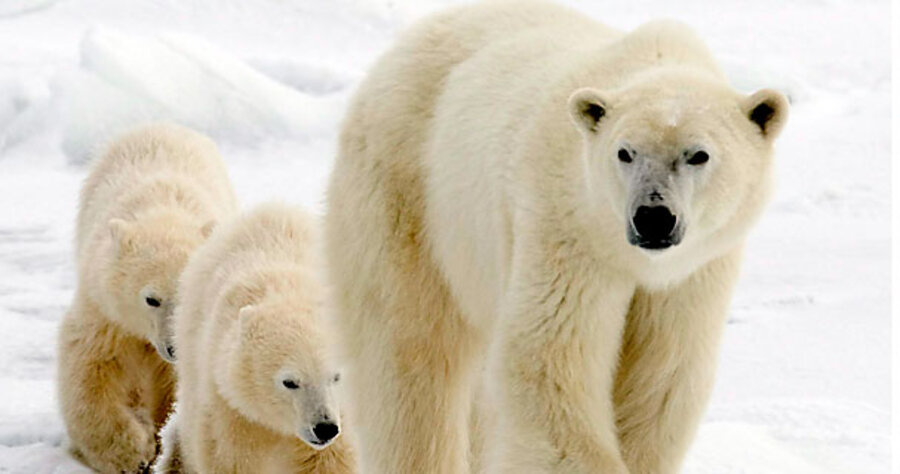Arctic sea ice melting faster than expected
Loading...
Arctic Ocean sea ice – one of the most visible indicators for global warming – may be headed for another record-breaking summer decline.
If the pattern continues, new research suggests, its warming effect could reach up to 900 miles inland, melting permafrost and potentially altering weather patterns at lower latitudes.
As of June 7, preliminary data show that the vast expanse of ice at the top of the world is some 55,800 square miles smaller than it was on the same date last year, according to University of Colorado researcher Sheldon Drobot. In May, sea-ice extent was slightly large than in May 2007. But the melt rate during the month – some 3,000 square miles a day – was faster, according to the National Snow and Ice Data Center in Boulder, Colo.
The ice’s seasonal shrinkage in 2007 smashed records, reaching a September minimum of 2.6 million square miles – some 23 percent smaller than the previous record, set in 2005. If it sets another record this year, it would mark the fifth season of record declines since 1998.
“The next few weeks should be quite instructive, and by mid July we ought to have a very good sense of how things are shaping up,” says Dr. Drobot, who is using satellite data on ice extent to develop forecasts of seasonal changes in Arctic Ocean ice cover.
Typically, bright sea ice sends sunlight streaming back into space, keeping things relatively cool at the surface. Leftover ice at the end of the summer forms the foundation on which ice rebuilds during fall and winter. Over successive seasons, older, multi-year ice grows thicker and more resistant to a meltdown in subsequent summers than thin, single-year ice. Last year’s record decline, however, left a shaky foundation. Some 63 percent of the ice is younger than average, while only 2 percent is older than average, according to Drobot.
The prospect of more open water in the Arctic Ocean in summer would be a boon to shipping interests, greatly reducing the sailing time between Europe and Asia, for instance. Indeed, the prospect of increased shipping is a key driver for Drobot’s forecasting research. And countries bordering the Arctic Ocean are trying to stake their claim to extended territorial waters under the Law of the Sea Treaty to exploit resources believed to lie beneath the Arctic Ocean floor.
But from a climate standpoint, more open water during summer translates into warmer temperatures, since the dark seawater absorbs sunlight, stores the heat, then slowly releases it. This played a large role in last year’s summer melt-off, explains Don Perovich, a researcher with the US Army Corps of Engineers Cold Regions Research and Engineering Laboratory in Hanover, N.H.
He and colleagues published an analysis last week showing that ice in the Beaufort Sea – which stretches from Barrow, Alaska, east to Canada’s islands in the high Arctic – underwent what he terms an extraordinary amount of melting from underneath due to warm water. Some of that water may have flowed into the Beaufort Sea from the Pacific or via the Atlantic, he acknowledges. But buoy measurements locally point to “enough solar heat to easily be responsible for this huge amount of bottom melting and still have heat left over.”
The seawater retained enough residual heat, in fact, to significantly slow the freeze-up of sea ice heading into last winter. The intensity of this classic “ice-albedo feedback” may be one reason why the Arctic is responding so much faster to global warming than many climate models had projected, he says. The results appeared in the June 3 issue of Geophysical Research Letters.
The question now: “We see this big drop; are we going to hit a plateau and bounce around for a while or are we in free-fall?” he asks.
It’s a question whose answer may have implications well below the Arctic Circle. High-latitude warming – when reinforced by a five- to 10-year period of sudden, deep sea-ice meltbacks – could be 3.5 times higher than climate models typically project, according to a study published this week and prompted by last year’s sea-ice meltdown. Moreover, the added warmth extends as far as 900 miles deep into the North American and Eurasian continents.
“That was one of the real interesting aspects of this study – just how broad the impact can be,” says David Lawrence, a scientist at the National Center for Atmospheric Research who led the group. The earlier these extended periods of low-ice summers appear during this century, the study shows, the sooner the most vulnerable forms of permafrost melt, and the more vulnerable colder forms of permafrost become to later climate warming. His group’s study appears in the June 13 issue of Geophysical Research Letters.
The long-term climate implications of melting permafrost are unclear. Much depends on what happens to the hydrology of the region, Dr. Lawrence says. Carbon dioxide or methane could be the predominant gas vented as permafrost melts, depending on how wet or dry the region becomes. And as woodier vegetation migrates north, soaking up some of that CO2 in the process, the region still could emit enough methane – a far more potent greenhouse gas than CO2 – to offset the CO2 plants take up.
“The Arctic is a real challenge; it’s a complicated place up there,” he says.





